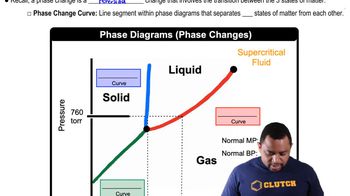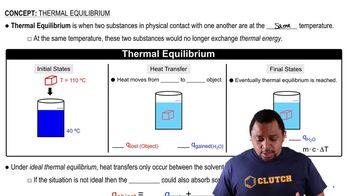Indicate whether each statement is true or false: (a) The liquid crystal state is another phase of matter, just like solid, liquid, and gas. (b) Liquid crystalline molecules are generally spherical in shape. (d) Molecules that exhibit a liquid crystalline phase show weaker-than-expected intermolecular forces. (e) Molecules containing only carbon and hydrogen are likely to form liquid crystalline phases. (f) Molecules can exhibit more than one liquid crystalline phase.
Ch.11 - Liquids and Intermolecular Forces
Chapter 11, Problem 71
It often happens that a substance possessing a smectic liquid crystalline phase just above the melting point passes into a nematic liquid crystalline phase at a higher temperature. Account for this type of behavior.
 Verified step by step guidance
Verified step by step guidance1
Step 1: Understand the nature of liquid crystals. Liquid crystals are substances that exhibit properties between those of conventional liquids and solid crystals. They have an ordered structure like solids but can flow like liquids.
Step 2: Differentiate between smectic and nematic phases. In the smectic phase, molecules are organized into layers, and within each layer, they have a degree of positional order. In the nematic phase, molecules are oriented in the same direction but do not form layers.
Step 3: Consider the effect of temperature on molecular motion. As temperature increases, the thermal energy of the molecules increases, which can disrupt the ordered layers of the smectic phase, leading to the less ordered nematic phase.
Step 4: Analyze the transition from smectic to nematic phase. The transition occurs because the increased thermal motion at higher temperatures overcomes the forces maintaining the layered structure, allowing the molecules to adopt the more fluid nematic arrangement.
Step 5: Relate this behavior to entropy. The transition from smectic to nematic phase is often driven by an increase in entropy, as the nematic phase allows for greater molecular freedom and disorder compared to the more ordered smectic phase.
Key Concepts
Here are the essential concepts you must grasp in order to answer the question correctly.
Liquid Crystalline Phases
Liquid crystals are materials that exhibit properties between those of conventional liquids and solid crystals. They can exist in various phases, including smectic and nematic, characterized by different molecular arrangements and orientations. The smectic phase has layered structures with molecules organized in planes, while the nematic phase has a more disordered arrangement with molecules aligned in a common direction.
Recommended video:
Guided course

Crystalline Solids Structure
Phase Transitions
Phase transitions refer to the changes in the state of matter that occur when a substance is subjected to variations in temperature or pressure. In the context of liquid crystals, as temperature increases, the energy of the molecules increases, leading to a transition from a more ordered phase (smectic) to a less ordered phase (nematic). This behavior is crucial for understanding the thermal properties and applications of liquid crystalline materials.
Recommended video:
Guided course

Phase Changes in Diagrams
Thermal Stability and Molecular Interactions
The stability of different liquid crystalline phases is influenced by molecular interactions, such as van der Waals forces and hydrogen bonding. As temperature rises, these interactions can weaken, allowing the system to transition to a phase with lower energy and greater disorder. Understanding these interactions helps explain why certain substances can exhibit distinct liquid crystalline behaviors at varying temperatures.
Recommended video:
Guided course

Thermal Equilibrium
Related Practice
Textbook Question
Textbook Question
Indicate whether each statement is true or false: (c) Molecules that exhibit a liquid crystalline phase do so at well-defined temperatures and pressures.
Textbook Question
For a given substance, the liquid crystalline phase tends to be more viscous than the liquid phase. Why?
Textbook Question
As the intermolecular attractive forces between molecules increase in magnitude, do you expect each of the following to increase or decrease in magnitude? (g) critical temperature.
